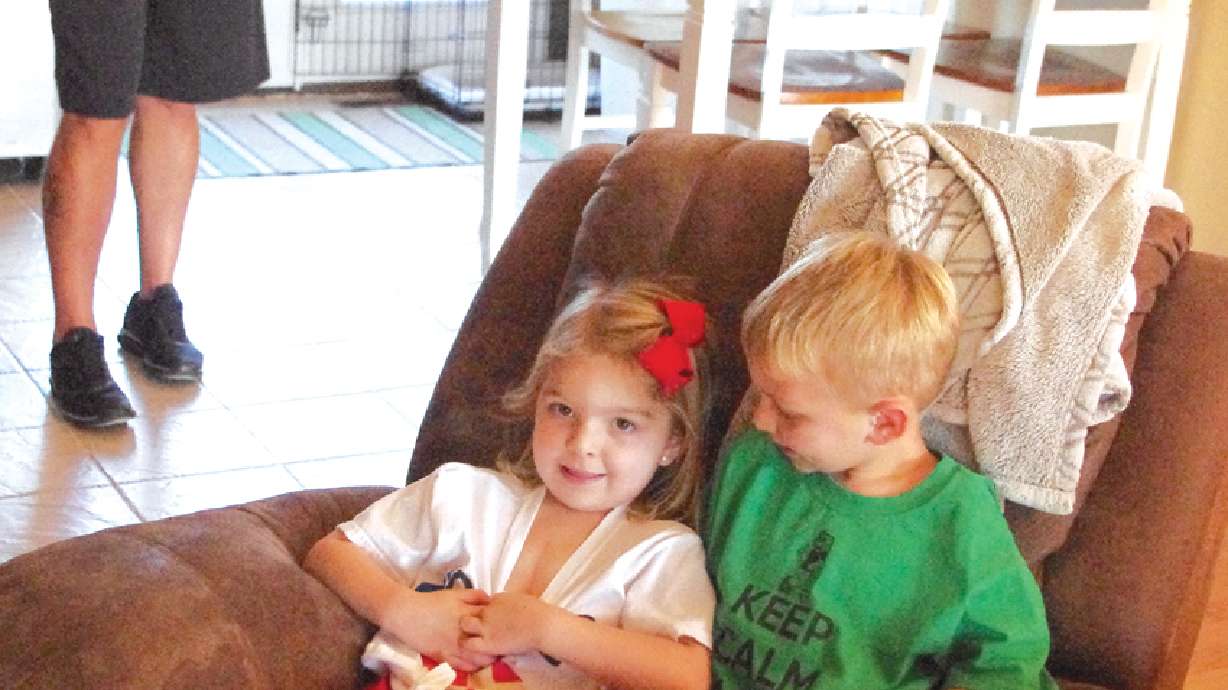Estimated read time: 4-5 minutes
This archived news story is available only for your personal, non-commercial use. Information in the story may be outdated or superseded by additional information. Reading or replaying the story in its archived form does not constitute a republication of the story.
GLASGLOW, Ky. (AP) — Bree Sponhouse is an energetic 4-year-old who loves to jump on the trampoline.
Bree, who was born with congenital heart disease, also likes to show people the scar on her chest, or her "zipline," as she refers to it.
Her pediatrician, Dr. Sandra Moss of Glasgow, detected a heart murmur when Bree was a day old. The abnormal heart sound is often a sign something may be wrong.
Further testing revealed that Bree had two holes in her heart. One was an atrial septal defect between the upper two heart chambers, the other a ventricular septal defect between the lower two heart chambers.
"We weren't really that concerned, because our son, who is 15 months older, was also born with a hole in his heart. It closed on its own by the time he was 6 months old," said Bree's mother, Paula. "So we thought, 'No big deal. She's got one too.' "
According to Dr. Smitha Bullock, a University of Louisville pediatric cardiologist who practices at Kosair Children's Hospital, the incidence of congenital heart disease in general is about eight in 1,000 births.
"Of all the congenital heart disease we see, a hole in the heart is the most common," she said.
A child with a hole in his or her heart can experience poor blood circulation, which causes the heart to work harder than normal, and can lead to other problems, such as an enlarged heart, valve leakage or respiratory problems. The possibility of a child having congenital heart disease increases if another child in the family also has it, Bullock said.
There are some genetic syndromes related to the development of holes in the heart, but a vast majority of them are not related to any known genetic defect, she said.
"The theory is that as the heart is forming in babies (during) pregnancy there are very small defects that happen when things don't form or change the way they are supposed to," Bullock said.
The formation of holes in the heart is not necessarily related to exposure of anything during pregnancy or any other identifiable cause.
"It's really a signaling problem within the molecules that occurred during the development of the fetus," Bullock said.
The Sponhouses were told there was a possibility the holes in their daughter's heart would close on their own, just like the one their son, Brody, had, so they thought their daughter would also be fine.
When Bree was 18 months old, her cardiologist said the holes had not closed and if they didn't soon, she may have to undergo a procedure to close them.
"I was a little devastated at that point, because, I thought, 'Oh gosh, she will have to have surgery one day,' " Paula said.
Two procedures can be performed to close holes in the heart. One is cardiac catheterization, while the other is cardiothoracic surgery, or an open-heart operation.
"Cardiac catheterization for children has been done for a long time, but to actually be able to fix the hole is relatively newer. It is nice to be able to have that to offer to families sometime when the child is actually a good candidate for that type of intervention," Bullock said.
How quickly a hole in the heart needs to be repaired depends on the size and the number of the holes.
Bree had to be a certain weight before she could undergo cardiac catheterization. She didn't reach that weight until this summer. The procedure was performed in June, but it didn't work. The closure devise doctors were trying to insert in the holes would pop out each time her heart beat.
Her cardiologist then determined she would need cardiothoracic. Bree turned 4 years old July 23 and had the surgery July 29 at Kosair Children's Hospital in Louisville.
The Sponhouses talked with Bree and prayed with her before the surgery.
"She was a strong little girl. She said Jesus was holding her hand during her procedure, so she wouldn't be scared," Paula said.
The surgery went well. Bree had it on a Tuesday, and by Thursday she was no longer taking painkillers and was off most machines.
"They sent us home Friday," her mother said. "She just did wonderful. We were just in awe and shock on how well she did."
For six weeks after the surgery, Bree's activity was restricted. She couldn't swim. She couldn't play on inflatables and she couldn't jump on the trampoline, even though that was the first thing she wanted to do when she came home from the hospital.
Her final check-up was Sept. 17 and doctors told her parents she was doing great.
The preschooler is now full of energy, something she was lacking before the surgery - and she's always eager to jump on the trampoline.
Copyright © The Associated Press. All rights reserved. This material may not be published, broadcast, rewritten or redistributed.








